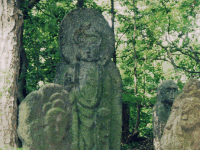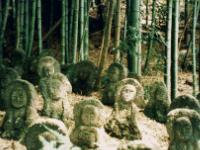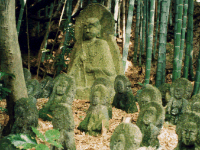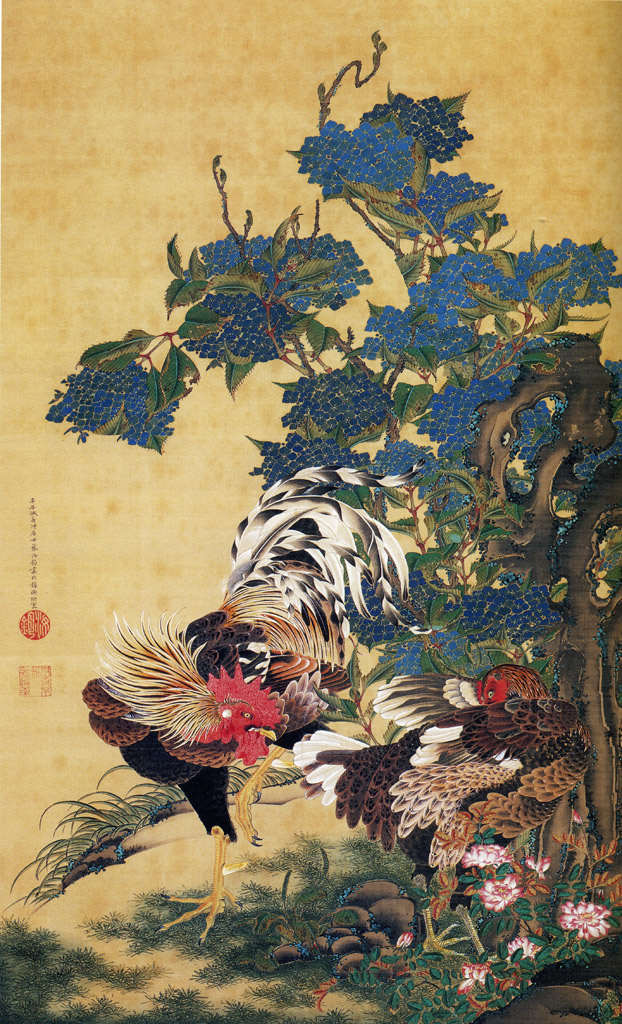In 1713 AD, Rev. Sengai Zenji of the Ohbaku Sect, known also as the third sect of Zen Buddhism in Japan, established
this temple. Behind the main hall in the mountain, there are five hundred statutes carved out of stone, each depicting
a disciple of Buddha who had attained Nirvana. This group of statues, called the Gohyaku Rakan (The 500 Arhats), was
captured in a sketch by the famous painter Jakuchu Itoh of the Edo Period. Jakuchu Itoh was born on February 8, 1716
as the eldest son of the vegetable wholesaler who owned "Masuya" located at the Takakura Nishikikoji Market at the southeast
corner of Kyoto. The name of store has been called "Masugen" for generations after the name of the master of the house
"Genzaemon Itoh". When Jakuchu was 23 years old, his father passed away at the age of 42 years old. So Jakuchu Itoh
took over the store as the 4th Genzaemon Itoh. He had never learnt how to draw since childhood. But then during the
second half of his twenties, he became interested in drawing and began to study at the Kano painting school.
At the beginning he tried to learn eagerly the Kano school's drawing technique. As he gradually felt unsatisfied due
to the mismatch of his talent, his interest gradually shifted to the copying of the original Chinese Song painting.
During those days he became acquainted with Taiten Kenjou, the priest of the Jiun hermitage of Sokokuji temple.
Taiten Kenjo became his lifelong spiritual pillar. Taiten advised him to change his name to Jakuchu.
It is a quote adopted from "Lao-tzu", meaning “Although the finished product seems to be missing some parts,
it cannot be used up.” This name seems to portray the appearance of Jakuchu's art.
At the age of 40 years old, he handed over the family business to his younger brother "Sougen" and retired to
concentrate on drawing pictures. His painting, basically based on the sketches of the animals and plants, is famous.
Notably the picture of the chicken is so realistic that it seems to be flying out of the painted canvass.
After being driven away by the "Kyoto Big Fire:The Tenmei Conflagration" which had happened on the New Year
of 1788, Jakuchu Itoh began to live with his younger sister in front of this Sekihoji temple. Then, he came up with
the idea of building the Gohyaku-rakan stone statues in the mountains behind the Sekihouji temple. When people wanted
to dedicate the disciple statue, Jakuchu Itoh would design the disciple statue for the cost of one "TO" of rice. “TO”
is the old Japanese unit of weight which is equivalent to about 18.04 pounds. With the money, he would carve out of
stone masons each Arhat, one by one, and votively arrange them. However, the building of the Arhats seemed to have
started at an earlier time as indicated in the published article about the "stone statue Gohyaku-rakan". Such an
article appeared two years before “The Tenmei Conflagration" in the pamphlet of "Shuui Miyako meisyo Zukai: Capital
Sightseeing Map".




Sekihoji temple laid ruined after Meiji Period (from 1868 AD). Because of the charitable spirit of Chief Bonze Ryuutan, we can now see each of the stone Buddha statues in broad area cleared of grass. “Rakan”is a pupil of Buddha and "Gohyaku Rakan" means five hundred excellent pupils. The stone Buddhist image sketched and drawn by Jakuchu's brilliant stroke of brush had long been exposed to wind and rain. This extended weathering causes the statues to be roundish and glazed with moss - creating a deepened sense of impression. The grave of Jakuchu Itoh is located at the south side of the main hall. 
|
|
|
Enlargemen |
|
| Thanks to Mr. D.M. | |